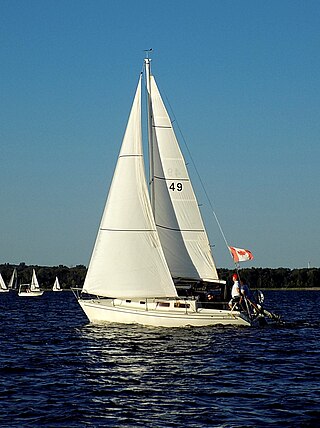Related Research Articles

The San Juan 21 is an American trailerable sailboat, that was designed by Don Clark as a cruiser-racer and first built in 1970.
The Santana 22 is an American trailerable sailboat, that was designed by Gary Mull and first built in 1966.

The Santana 20 is an American trailerable sailboat that was designed by W. Shad Turner as a day sailer, one design racer and pocket cruiser. It was first built in 1976.
The Santana 27 is an American sailboat, that was designed by Gary Mull and first built in 1967. The design is out of production.
The Santana 37 is an American sailboat, that was designed by Gary Mull and first built in 1969. The design is out of production.

The Sonic 23 is a Canadian sailboat, that was designed by Joseph D'Alessio and first built in 1981.

The Schock 23 is an American trailerable sailboat, that was designed by Steven Schock, with a wing keel designed by Finnish engineer Reijo Salminen and first built in 1987.
The Santana 30/30 is an American sailboat that was designed by Bruce Nelson and Bruce Marek as a Midget Ocean Racing Club (MORC) racer-cruiser and first built in 1981.
The Santana 21 is an American trailerable sailboat that was designed by Seymour Paul as a lightweight racer-cruiser and first built in 1969.
The Santana 25 is an American trailerable sailboat that was designed by W. Shad Turner as an International Offshore Rule Quarter Ton class racer and first built in 1973. The boat was Turner's first design.
The Santana 2023 is a family of American trailerable sailboats that was designed by Steve Schock, with models for racing and cruising, first built in 1993.

The Wavelength 24 is an American trailerable sailboat that was designed by Paul Lindenberg as a Midget Ocean Racing Club (MORC) racer and first built in 1982.
The Seafarer 24 is an American trailerable sailboat that was designed by McCurdy & Rhodes as a cruiser and first built in 1974.
The Endeavor 26 is an American trailerable sailboat that was designed by Bill Lapworth as a racer and day sailer and first built in 1963.
The Santana 228 is an American sailboat that was designed by W. Shad Turner as a cruiser and first built in 1978.
The Santana 26 is an American trailerable sailboat that was designed by W. D. Schock Corp's in-house designer, Seymour Paul, as a cruiser and first built in 1971.
The Santana 35 is an American sailboat that was designed by W. Shad Turner as a racer-cruiser and first built in 1978.
The Santana 525 is an American sailboat that was designed by W. Shad Turner as a one design and International Offshore Rule Quarter Ton class racer-cruiser and first built in 1977.
The Schock 35 is an American sailboat that was designed by W. Shad Turner as a racer-cruiser and first built in 1984.

The Wavelength 30 is an American sailboat that was designed by Paul Lindenberg as a racer-cruiser and first built in 1980.
References
- ↑ "Schock W.D." Archived from the original on 24 April 2024. Retrieved 24 April 2024.
- 1 2 3 4 5 6 McArthur, Bruce (2021). "Santana 23 sailboat". sailboatdata.com. Archived from the original on 19 December 2021. Retrieved 19 December 2021.
- 1 2 3 4 5 6 7 8 Henkel, Steve: The Sailor's Book of Small Cruising Sailboats, page 248. International Marine/McGraw-Hill, 2010. ISBN 978-0-07-163652-0
- ↑ McArthur, Bruce (2020). "Schock W.D." sailboatdata.com. Archived from the original on 18 July 2020. Retrieved 19 December 2021.
- ↑ "Schock W.D." Archived from the original on 24 April 2024. Retrieved 24 April 2024.
- 1 2 W. D. Schock Corp. "Boats built by W.D. Schock". wdschock.com. Archived from the original on 21 February 2010. Retrieved 9 August 2022.